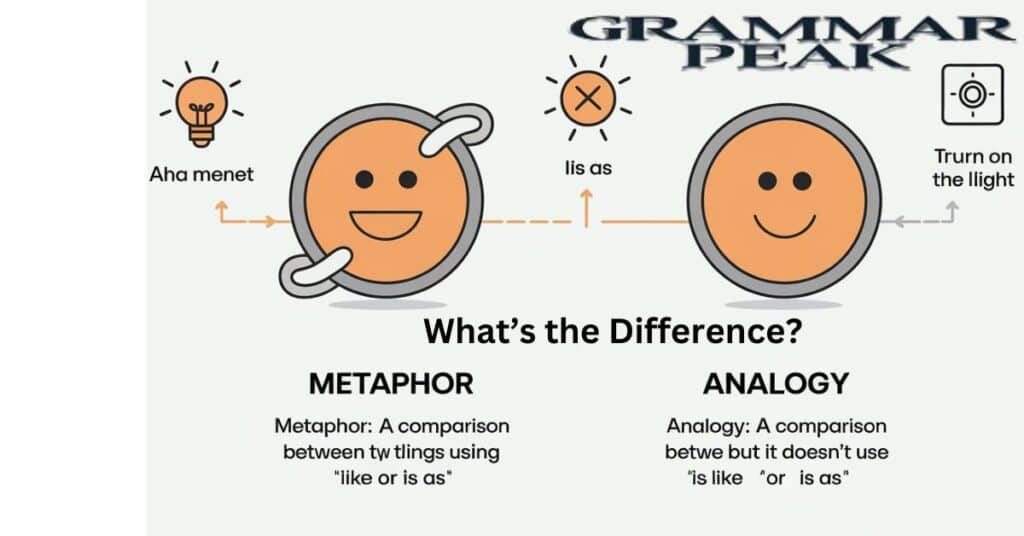Understanding the difference between metaphor vs analogy is essential for effective writing and communication. Both are powerful figures of speech that can clarify complex ideas and enhance your message. While they share similarities, they serve different purposes.
In this article, we will explore the definitions, characteristics, and uses of metaphors and analogies. We will also provide examples to illustrate their differences. By the end, you’ll have a clearer understanding of how to use these creative writing techniques effectively.
Metaphor
A metaphor is a figure of speech that makes a direct comparison between two unrelated things. Metaphors can simplify complex concepts. They turn abstract ideas into relatable images.
This makes it easier for readers to grasp the intended meaning This comparison does not use “like” or “as,” which distinguishes it from a simile.
| Feature | Explanation |
| Types of Metaphors | Can include extended metaphors, implied metaphors, and dead metaphors, each serving different functions in writing. |
| Structure | Typically involves a direct comparison that does not use explicit connecting terms. |
| Emotional Impact | Evokes strong feelings and imagery, enhancing the reader’s emotional connection to the text. |
| Common Uses | Widely used in poetry, literature, and rhetoric to convey deeper meanings and themes. |
| Visual Metaphors | Often rely on vivid imagery to create mental pictures that resonate with the audience. |
| Conceptual Metaphors | Provides a framework for understanding abstract concepts through more tangible images. |
| Cultural References | Metaphors can reflect cultural values and beliefs, making them powerful tools for communication. |
| Limitations | May lead to confusion if the comparison is too obscure or not easily understood. |
| Effectiveness | Highly effective in enhancing writing style and making complex ideas more relatable. |
| Examples in Literature | Frequently found in famous literary works, enriching the text with layers of meaning. |
Explore these Metaphor vs Analogy: What’s the Difference?
Analogy
An analogy is a comparison between two things that are alike in some way. It explains a complex idea by relating it to something familiar.
- Clarifying the Unknown: Analogies simplify difficult concepts by linking them to common experiences, making the unknown more relatable and easier to grasp.
- Illustrating Concepts: By using analogies, we can paint a vivid picture of complex ideas, transforming abstract thoughts into tangible examples that resonate with our understanding.
- Connecting Ideas: Analogies draw parallels between different subjects, allowing us to see connections and relationships that enhance our comprehension of intricate topics.
- Bridging Gaps: Analogies help bridge gaps in knowledge by relating unfamiliar concepts to everyday situations, allowing for a smoother understanding of complex themes.
- Enhancing Retention: By comparing new information to familiar contexts, analogies improve memory retention, making it easier to recall complex ideas when needed.
| Feature | Explanation |
| Types of Analogies | Can include similes, metaphors, and allegories, each serving a different purpose in comparison. |
| Structure | Often follows a format that highlights similarities between two different concepts or objects. |
| Cognitive Function | Helps in cognitive processing by linking new information to existing knowledge for better retention. |
| Common Uses | Frequently employed in education, literature, and everyday conversation for clarification. |
| Visual Analogies | Use visual representations to illustrate similarities, such as diagrams or charts. |
| Analogical Reasoning | A method of reasoning that draws conclusions based on the similarities between different situations. |
| Cultural Variations | Different cultures may use analogies differently based on their values and communication styles. |
| Limitations | May oversimplify complex ideas or lead to misunderstandings if the comparison is not appropriate. |
| Effectiveness | Highly effective in teaching and persuasive writing, as it engages the audience’s understanding. |
| Examples in Literature | Commonly found in literary works, such as fables or parables, to convey moral lessons. |
You will like Metaphor vs Analogy: What’s the Difference?
Metaphor vs Analogy: The Differences
Metaphor: A metaphor is a figure of speech that makes a direct comparison between two unrelated things by stating that one is the other, creating a vivid image.
For example, “Her eyes were stars” suggests brightness and beauty without literally meaning her eyes are stars.
Analogy: An analogy explains a complex idea or concept by comparing it to something more familiar, helping clarify the unfamiliar.
For example, “Learning a new language is like climbing a mountain” illustrates the challenges and gradual progress involved in language acquisition.
Focus
- Metaphor: A metaphor offers a direct and imaginative comparison between two different things, enriching the text with emotional depth and resonance. It’s like a creative spark that ignites the reader’s imagination. (e.g., “Time is a thief.”)
- Analogy: An analogy provides a more extended comparison to clarify or explain a concept by showing how two different things are similar in some way. It serves as a helpful guide, making complex ideas more accessible. (e.g., “The internet is like a vast ocean of information.”)
Structure
- Metaphor: Typically presents a direct comparison without using connecting phrases, which creates a bold and immediate effect. This approach can intensify the emotional response but may require deeper interpretation from the reader.
- Analogy: Usually employs connecting words such as “like” or “as,” making the comparison more explicit and relatable. This structure helps clarify complex ideas, making them easier to understand, but can sometimes be less impactful than a metaphor.
In a Nutshell
In a nutshell, the main difference between metaphor and analogy lies in their function.
- Metaphor: Think “implied meaning.”
- Analogy: Think of “clarifying comparison.”
Summary
- Metaphor: Metaphors focus on conveying deeper emotional truths through direct comparisons, enhancing the richness of language and thought.
- Analogy: Analogies aim to explain or simplify complex ideas by drawing parallels between familiar and unfamiliar concepts, facilitating understanding and insight.
| Aspect | Metaphor | Analogy |
| Definition | A figure of speech that implies a comparison between two unlike things without using “like” or “as.” | A reasoning or explanation that shows how two different things are similar in certain aspects. |
| Purpose | To create a vivid image or convey deeper meaning. | To clarify or explain a concept by highlighting its similarities to something more familiar. |
| Complexity | Often more abstract and open to interpretation. | Typically more straightforward, providing a clear rationale. |
| Emotional Appeal | Evokes strong emotions through imagery and symbolism. | Engages the intellect by drawing logical comparisons. |
| Language Style | Usually concise and poetic in nature. | Often more detailed and explanatory, using extended comparisons. |
| Examples | “Time is a thief.” | “A computer is like a brain, processing information and making decisions.” |
| Context | Commonly found in literature, poetry, and artistic expressions. | Frequently used in teaching, arguments, and everyday conversation to aid understanding. |
| Interpretation | Often requires the audience to infer the meaning. | Generally more direct, leading the audience to a clear conclusion. |
| Flexibility | Can be used in various forms, allowing for creative expression. | Typically follows a logical structure that may limit creative variations. |
| Cognitive Effect | Stimulates imagination and encourages personal interpretation. | Aids comprehension by connecting new ideas to existing knowledge. |
Using Metaphor and Analogy in Writing and Communication
Identify Your Goal
- Striking Image (Metaphor): Are you looking to evoke strong feelings or convey an abstract concept in a powerful and imaginative way?
Example: “The world is a stage, and we are merely players.” - Clear Explanation (Analogy): Do you want to help someone understand a complex idea by relating it to something familiar and straightforward?
Example: “Just as a caterpillar transforms into a butterfly, learning can lead to personal growth and change.”
Choose Your Source Material
- For Metaphors: Choose elements that resonate deeply, such as personal experiences, cultural references, or universal themes. Think about using colors, emotions, or dynamic actions that can create strong connections in the reader’s mind.
- For Analogies: Opt for familiar concepts or everyday situations that can serve as relatable touchpoints. Draw from common knowledge, historical events, or simple activities that can illustrate your point effectively and enhance understanding.
Ensure the Comparison Makes Sense
- Metaphors: Confirm that your imagery is coherent and impactful. Steer clear of vague or convoluted comparisons that may confuse the reader or dilute the intended message.
- Analogies: Verify that the relationship between the two elements is relevant and straightforward. Avoid overly complex or unrelated comparisons that could mislead or create misunderstandings.
Keep it Fresh (but Not Forced)
To keep your writing engaging, strive for originality. Avoid clichés and overused comparisons. Instead, look for fresh ways to convey your ideas. A unique perspective can make your writing stand out.
Consider the Context
Context is vital when using metaphors and analogies.
- Consider the audience and the situation.
- What works in one context may not work in another.
- Tailor your writing to fit the needs of your readers.
Origins of Metaphor and Analogy
Metaphor
Metaphors have ancient roots, emerging from the need to express complex ideas in a more relatable and vivid manner. They can be traced back to early languages and oral traditions, where storytelling relied heavily on figurative language to convey emotions, experiences, and cultural values.
As societies evolved, metaphors adapted, reflecting the changing landscapes of human thought and expression. The study of metaphor has gained prominence in various fields, including literature, psychology, and linguistics. Scholars like Aristotle have explored the power of metaphor in shaping human understanding, while contemporary researchers examine its cognitive implications.
Analogy
Analogies have been instrumental in communication and reasoning throughout history, serving as bridges between unfamiliar and familiar concepts. They allow individuals to draw parallels and make connections, facilitating understanding in various fields, from science to literature.
By comparing one thing to another, analogies simplify complex ideas and enhance cognitive engagement, making them valuable tools in both academic and everyday discourse. In addition to their educational significance, analogies are often employed in creative writing and rhetoric to evoke emotions and paint vivid images.
Examples in Context
Metaphor
- Life is a rollercoaster.
- Her heart is a locked vault.
- The world is a stage.
- Hope is a fragile flower.
- Knowledge is a light that guides us.
- His words were a double-edged sword.
- The classroom was a battlefield.
- She has a heart of stone.
- The city is a jungle.
- Dreams are the stars in our sky.
Analogy
- A heart is like a pump, circulating love through the body.
- Learning a language is like building a bridge between cultures.
- Navigating life is like sailing a boat through turbulent waters.
- A good book is like a window, offering a view into new worlds.
- The internet can be compared to a vast ocean, full of information and mystery.
- A team is like an orchestra, where each member plays a vital role.
- Cooking is like chemistry, where the right ingredients create magic.
- A relationship is like a garden, requiring care and nurturing to thrive.
- Memories are like photographs, capturing moments in time.
- A business is like a machine, with various parts working together for success.
FAQ” S
What is the main difference between metaphor and analogy?
The main difference is that a metaphor creates a striking image, while an analogy provides a clear explanation of a complex idea.
Can metaphors and analogies be used interchangeably?
No, they serve different purposes and should be used according to the context and goals of your writing.
How do I know when to use a metaphor or an analogy?
Identify your goal. If you want to evoke emotion, use a metaphor. If you want to clarify a complex concept, use an analogy.
Are metaphors and analogies common in everyday language?
Yes, both are widely used in everyday language and literature to enhance communication and understanding.
Can I create my metaphors and analogies?
Absolutely! Creating unique metaphors and analogies can make your writing more engaging and relatable.
Conclusion
In conclusion, understanding the differences between metaphor vs analogy is essential for effective communication. Both tools enhance your writing and help convey complex ideas with clarity. By mastering these creative writing tools, you can improve your ability to express thoughts and connect with your audience.

Mason Blake is an experienced blogger with a passion for language and communication. With years of expertise in crafting informative and engaging content, Mason shares valuable insights on grammar and writing. His clear, concise, and reader-friendly approach has earned him a loyal following, helping readers sharpen their language skills and master the art of effective communication.







